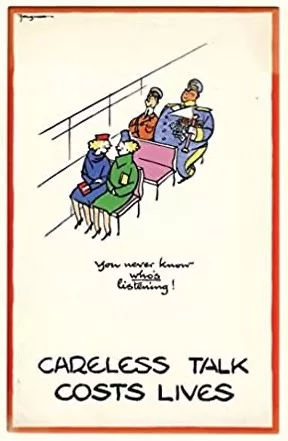On this page: Propaganda Postcards of WWII ° How to Store a Postcard Collection ° The Market for Collecting Postcards
Rich in both historic and artistic interest, propaganda and military postcards of World War I and World War II are an accessible category for collectors at all levels.
The acknowledged golden age of collectible postcards (1893-1918) ended with the first World War; prior to that time, Germany had been the primary source of high-quality, inexpensive color processing and printing.
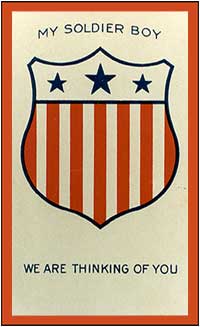

With the coming of the war, America began doing its own printing to make up for the demand, but the available papers and inks didn’t match the pre-war quality — a fact that discourages many potential collectors. This, combined with the large volume of cards produced, keeps market values quite reasonable.
Here is a crash course in Deltiology 101 (the collecting of postcards; the study of small images)
Especially in the World War I era, the postcard was a primary means of communication. You didn’t have timely news reports from the battlefield; most homes didn’t have radios, and newspapers were printing old news.
Itinerant photographers were taking pictures, printing them and selling them on the street, so the postcards from soldiers depicting bombings of cities and other activities around them were often the most timely news coming home.
Even during WWII, when we had better communications technology, this was still true to some extent.
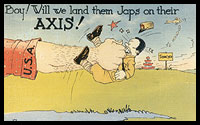

World War I and World War II postcards display a variety of subject matter and artistic style. Most cards are either photographic (black and white; color photography postcards didn’t come along until the 1950s) or artist-illustrated (predominantly color).
Some wartime images depict naval shipping, Red Cross messages, military leaders, soldiers or flags, while outright propaganda is more pointedly designed to recruit public opinion toward a given cause.
In World War I, Britain was forced to declare war when Germany invaded Belgium. They had the most sophisticated propaganda, because they had to start immediately to convince their citizens that it was the right thing to do.
Early in the war, Americans were the target of German propaganda trying to keep us out of the war, and British propaganda trying to get us to join — and once we joined the effort, we needed our own propaganda.
Examples of American World War I propaganda postcards include illustrations of German leaders with pig faces and images emphasizing the ravages of war, such as an artist’s illustration of a mother leaning over a dead child with the inscription, “The Germans have passed through here”.
Many World War II cards employed caricature to get their message across, such as an image of a big U.S.A. fist knocking the teeth out of a cartoonish Japanese solider.
Other common World War II images include the famous “Loose Lips Sink Ships,” and messages stressing the importance of rationing gas and other precious resources.
These images were intended to get people involved on two fronts: to get approval for the cause, and to serve as a morale-builder, to maintain the feeling of patriotism for both troops and civilians.
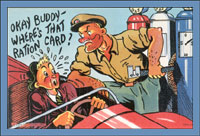

Postcard condition is crucial, with significant damage reducing a card’s value by half. In general, if the card has been postally used, it may decrease the condition and value.
However, in terms of propaganda cards, if the written message has strong emotional content relating to the war or to the propaganda on the face of the card, that would increase the card’s value — unless the card is in terrible condition or the writing covers the image on the front.
But most of the time, we find the written messages have nothing to do with the image.
How to Store a Postcard Collection
As for storage, keep your collection of rare and valuable postcards loose in a safe deposit box — dark, cool and safe. We recommend:
Your storage method should be based on how often the cards will be handled. If you want to have them out where people can go through them, then you want to use rigid plastic sleeves. Any five-year-old can pick it up and not damage the card. But don’t get too hung up on archival sleeves. If you keep them at home, chances are you don’t have the right temperature and humidity conditions to be considered archival storage.
If you have a large collection, store them in albums with PVC sleeves.
If the cards will be exposed to extreme conditions (for instance, if you don’t have air conditioning), You’re better off storing them naked so they can breathe. I see people at flea markets with their cards in protective plastic sleeves, but they’re sitting out in the hot sun with condensation forming inside them.
Some collectors invest in a fireproof safe, howweve, if you actually have a fire, the first thing the safe does is leech ruinous chemicals or fluids all over the contents.
The Market for Collecting Postcards
There has been increased market interest in the last few few years, possibly aided by the recent spate of World War II books and films, and because this genre is inexpensive in relation to other postcard categories.
Though there is more market interest in the older World War I cards, some collectors prize the World War II-era “linen” cards. Printed on textured paper resembling linen fabric, linens are the only truly American printing process, never copied in Europe.
In general, values for cards of both eras are about equal. An unusual artist-illustrated card might go for $50-75, and a card woven in silk or an image depicting a sinking ship might be valued at over $100. But those cards are rare. The majority of World War I and World War II military cards will run under $10.
You’ll find some antique postcards in on-line auctions, but retail availability is quite limited, with only a few stores scattered around the nation.
Further Reading:
- Propaganda Postcards of World War II by Ron Menchine
- The Postcard Price Guide, 4th Ed., A Comprehensive Reference by J. Mashburn
- World War II Homefront Collectibles: Price & Identification Guide by Martin Jacobs
- As an Amazon Associate, I earn from qualifying purchases.
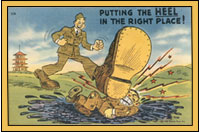

Propaganda Postcards & Cartoons of WWII
Sometimes funny, sometimes poignant and often witty or incisive comments on the progress of the war, cartoons of the British at war are now collectable
The years of World War 2 encompassed one of the greatest ages of cartooning.
The press was the chief communicator of news at that time and day after day for the duration of the war, the popular cartoonists of British newspapers such as the Evening Standard, Daily Mirror, Daily Express and News Chronicle vied with each other to make the most incisive and witty comments on the progress of the war at home and on the various fronts.
Through the press and radio, the British public were better informed about events than ever before in history. They were also, tragically, more personally involved.
The cartoonists of the time fulfilled an important function. Using the visual medium, they mounted an instantly comprehensible campaign against the mindlessness and inhumanity of Hitler’s war and at the same time gave a light-hearted view of wartime events and circumstances at a time when light heartedness was not a common quality.
Heckling Hitler
Hitler and the Nazi movement were, from the early 1930s, obvious targets for artists like David Low whose cartoons for the Evening Standard so enraged Goebbels in 1933 that his works were banned in Germany, well before the outbreak of the war.
His simple but powerfully drawn cartoons were often astonishingly perceptive. He attracted a huge following in his time and today his work is still compelling.
A couple of other outstanding political cartoonists were, like Low (a New Zealander), foreigners. Vicky (Victor Weisz) was the star in the News Chronicle’s constellation and later the man to famously depict Tory prime minister Harold Macmillan as ‘Supermac’. Philip Zec similarly produced some telling images for the Daily Mirror.
Home-grown commentators to look out for are Giles who, on more than one occasion, brings a sparkling comic humour to many of the wartime situations.
Anton, similarly, depicted ordinary Britishers coping with the war. Osbert Lancaster, too, used his inimitable style to produce a satirical comedy of manners of the British upper class at war.
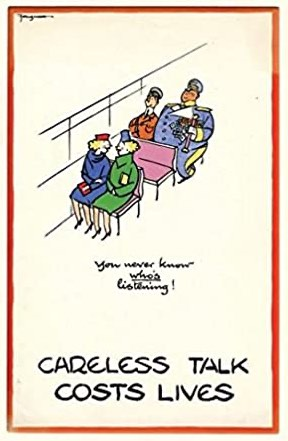

Fougasse (Cyril Kenneth Bird) was one of Punch’s most notable 20th-century cartoonists. His works are among the most interesting from a visual point of view in that they are not only technically accomplished but also extremely elegant and simple.
As well as cartoons, he drew the design for one of the famous ‘Careless Talk Costs Lives’ posters.
Postcard Collector’s Notes
Many 20th-century cartoons are relatively undervalued, although they provide a fascinating social and historical record of the time and arc visually appealing. But, like other ephemera such as pop collectables, they are making something of a show in auctions and arc now carried by a few specialist dealers.
Cartoons of World War 2 were produced in their thousands not only by famous and popular artists such as Low and Vicky but also by people who worked for provincial and foreign newspapers and magazines. In theory, a lot of these should have survived.
Finding an Original Cartoon
An original cartoon is the artist’s actual drawing from which the newspaper (or magazine) cartoon was reproduced. Most World War 2 ones are simply in pen and ink, since there was no colour reproduction in newspapers, and many carry a title or caption, as well as the artist’s signature.
Although the really famous and most memorable works of artists like Vicky and David Low will be in museums or private collections, there are still many others to be found, simply because the cartoons were produced on a daily basis for many newspapers.
Prices vary, depending on the subject matter. A Low cartoon commenting on an obscure event in the war, now forgotten by all but military historians, can often be picked up at auction for a quite reasonable sum while an important or interesting work can fetch ten times as much.
Less pricey are works by Osbert Lancaster which can sometimes be found quite cheaply, and for lesser known Punch cartoonists such as Frank Reynolds and others, bargain prices can quite often be paid.
World War 2 cartoons will often appear among a general sale of original illustrations at auction sales in both London and the provinces.
Some dealers specializing in modern prints and drawings will also sell them, along with other works. The canny collector, who is prepared to do a little research on the cartoon artists of period, may also pick up items in antiques markets and fairs and in house clearance sales.
Further Reading:
Media Control: The Spectacular Achievements of Propaganda by Noam Chomsky
Propaganda Postcards of World War II by Ron Menchine
The Postcard Price Guide, 4th Ed., A Comprehensive Reference by J. Mashburn
World War II Homefront Collectibles: Price & Identification Guide by Martin Jacobs by Noam Chomsky
Goebbels: Mastermind of the Third Reich by Walter Frentz
Berlin Calling by John Carver Edwards
Propaganda Postcards of World War II by Ron Menchine
The Postcard Price Guide, 4th Ed., A Comprehensive Reference by J. Mashburn
World War II Homefront Collectibles: Price & Identification Guide by Martin Jacobs
As an Amazon Associate, I earn from qualifying purchases.
Related stories
Fake Photo: Manipulated photography before Photoshop
Faked photos for Soviet propaganda

